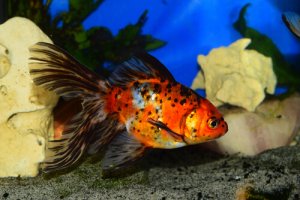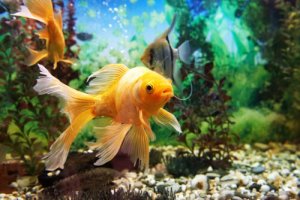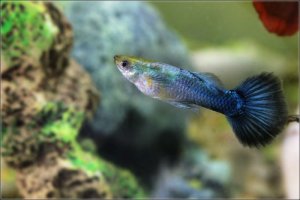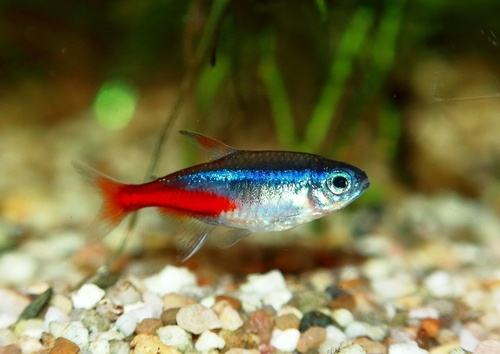
Neon Tetras are small schooling fish, and like many small schooling fish, they don’t have particularly long lifespans. Most Tetras live only from 2-5 years – a big difference from species like the Pleco that can live up to 15 years.
However, it’s inevitable you want all your fish to live as long as possible, and when kept in good conditions, there’s no reason why these little Tetras cannot live to the maximum point of their lifespans. Read on to find out what factors affect this, and what you can do.
Why Might Your Neon Tetras Die Earlier?
It’s an unfortunate fact that, especially if you are a beginner aquarist, some fish might die occasionally. However, every fishkeeper wants to ensure their fish live their maximum lifespan, and thus, it can be helpful to examine why Neon Tetras may occasionally die within the first or second year of you keeping them.
There are many reasons why fish might die earlier, including, but not limited to the following:
- Disease
Disease is a leading cause of fish death and if not caught early, diseases like swim bladder disease, fin rot, and dropsy can take a toll on your fish’s health. Fish disease does not have to be a death sentence and can be easily treated.
Author’s Note: longer you leave a sick fish without treatment, the more likely it is it will die of what might have been an otherwise preventable disease. Therefore, it’s best to learn how to spot these symptoms and stop them early.
- Aggression from other tankmates
Neon Tetras are generally placid and hardy fish but aggression can and does happen, especially from other tankmates that can be fin nippers. Some fish species can live together but this is dependent on them having enough space and the correct conditions. A good example is the betta fish, which can peacefully coexist with many species if they have separate territories but which can turn aggressive if it feels threatened.
A good understanding of the behavior of the other tankmates in your tank can prevent this. Aggression can take the form of fin-nipping, chasing, and out-competing your Tetras for food. This can cause premature fish death from stress, which can increase disease susceptibility, or in serious cases, from wounds and infections.
- Tank accidents
If your tank is not properly set up, tank accidents can often befall fish, especially smaller fish like Neon Tetras, as well as fish that have delicate fins or are slow swimmers (such as some varieties of fancy goldfish).
One of the most common tank accidents is a fish getting sucked into the filter or stuck somewhere in the tank. This generally happens if your filter strength is inappropriate for the species of fish you have chosen to keep. Neon Tetras are strong swimmers, but they are small, and a good filter flow rate tends to average around 4x the tank capacity per hour. They do not need a strong current, unlike some pleco and hillstream loach species.
However, they can do reasonably well in tanks with strong currents provided there is enough space for them to escape the filter input and outflow.
- Poor conditions
Poor conditions generally increase the amount of bad bacteria in the water. This can cause diseases like fin rot and generally lower your fish’s immune system.
However poor tank conditions can also cause other issues like nitrate, nitrite, and ammonia poisoning. Ammonia poisoning can cause serious burns, manifesting as dark patches, on your fish’s body. Your fish turning black can happen to any species, and is best to keep an eye out for.
Author’s Note: Fish can tolerate barely any levels of ammonia at all. For a healthy tank, levels should always be at zero, so this is one of the most important parameters to regularly test for if you see back patches appear on any of your fish.
- Predation
Similar to fish aggression, predation happens when tankmates are poorly chosen and you have larger, aggressive fish with small Neon Tetras. Generally, once you’ve learned about which fish get on with each other this is easy to avoid.
Neon Tetras can work with angelfish and discus fish as well as small Amazonian cichlids but even in a very large community tank, larger cichlids like the Oscar and Jack Dempsey should be avoided, as well as many African species of cichlid. Any fish that eats smaller fish in the wild is not a good fish to mix with Neon Tetras.
What Is The Average Lifespan Of Neon Tetra Fish?
The average lifespan of Neon Tetra fish is anywhere from 2-5 years. This is quite a large range and honestly really depends on how well you take care of your fish. Factors like tank size, water clarity, and stress from tankmates can all affect your lifespan. So, if you want to ensure your Neon Tetras lifespan hits the 4-year mark, read on to find out what measures you can take and how they work.
How To Extend The Lifespan Of Neon Tetra
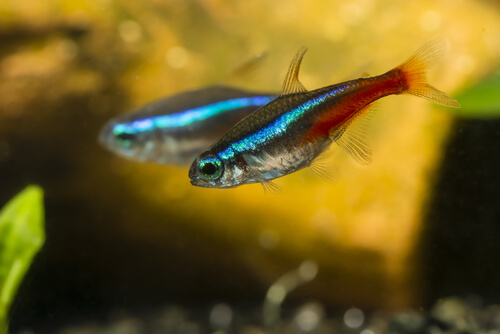
1. Good Diet
A healthy and varied diet is crucial for promoting a long lifespan in any fish. Neon Tetras are omnivores. They can eat fish flakes, but they will also enjoy fresh or frozen protein.
Always make sure this comes from a reputable source. Commercial fresh or frozen protein at your local aquatics store is generally subject to strict sanitation controls, but protein from unprofessional sources can introduce parasites to your fish tank.
Never overfeed or underfeed your fish! If you underfeed, your fish won’t have enough energy and will be more susceptible to disease. Overfeeding, on the other hand, can cause a whole host of digestive issues which can lead to disease and premature death.
Feed once a day and only feed what your fish can eat in 5 minutes. It’s also best to remove all uneaten food afterward.
What Is The Best Neon Tetra Food For Optimum Health
Due to their small mouth size, a Neon Tetra is best suited to a flake food, as opposed to sinking pellets. They spend most of their time midwater and enjoy coming up to the surface of the water to feed. Thus, flakes they can eat from the surface are best.
However, as mentioned enough, a varied diet is the best for any fish. However, if you choose to feed protein, do so only once or twice a week.
2. Appropriate Environment
How Neon Tetra Tankmates Help Reduce Stress
Neon Tetras are schooling fish, so they really cannot be alone. Don’t be tempted to include a Neon Tetra in a random group of other small fish. They are not interchangeable, and as a result, all your fish will only get stressed.
Neon Tetras do best in a group of five to six of their own kind. As schooling serves as a defense from predation in the wild, they need this safety in numbers to avoid stress.
Choosing the right tankmates of a different species can also help avoid stress. Any fin-nipping or aggressive fish can potentially compete with your Tetras and larger fish will appear as a threat – see predation section.
Why A Planted Tank Is Better
If you’re operating on a budget, it may be tempting to buy a small tank and put some Tetras in it. However, in their natural habitat, these fish swim amongst plants and between rocks and driftwood in a complex and natural environment.
Even though they are potentially bred in captivity, exchanging this for a bare tank environment means your fish do not have an outlet to express these natural behaviors. This can cause aggression or other forms of stress, and increase disease susceptibility.
Author’s Note: Plants also help maintain a tank ecosystem, filtering nitrates, nitrites, and ammonia from the water, providing places for pregnant fish to lay their eggs, shy fish to hide, and much more. Scientists have found that plants help fish live longer, have better quality of life, and can even have a calming effect on humans, too!
3. Catching Disease Early
Treating fish disease can be a delicate process, and as a result, it’s recommended all beginner fishkeepers have a spare tank on hand so that they can easily quarantine and isolate a fish if anything goes wrong. Fish diseases do happen occasionally but luckily, they are generally treatable if you know what to look for, so read on for some common causes of illness.
Common Types Of Neon Tetra Disease and Parasites
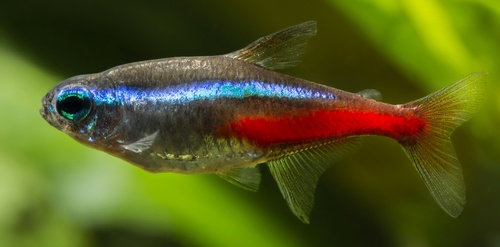
- Fin Rot
Fin rot is a bacterial infection that manifests as ragged and sore patches on your fish’s fins. It is not always as noticeable in neon Tetras as it is in fish with longer fins liek the betta fish.
However, it is a sure sign that your water is dirty and can be very painful for the fish. As a bacterial infection, it’s best to treat it with antibacterial medication in a separate tank so you do not inadvertently give the rest of your fish medicine they don’t need.
- Dropsy
Of all the diseases listed here, this is the only one that generally spells a death sentence for fish. This is a serious infection of the kidneys that causes your fish’s body to swell with water and its scales to stick out like a pinecone. Generally, there is no cure, so make sure you keep your water as clear as possible to prevent this.
- Ich
Ich is a parasitic infection and thus must be treated differently, generally with a saltwater bath in a quarantine tank to kill the parasite. Fortunately, it is easy to spot on your colorful Neon Tetras, as it manifests as small white spots on your fish’s body.
- Gold Dust
Similar to ich, gold dust is a parasitic infection that looks like flecks of gold on your fish’s body. You may mistake it for a beautiful part of your fish’s natural coloring showing through but make no mistake, it’s a sign your fish is sick.
You may also hear gold dust called ‘velvet disease’. Either way, it can be treated in the same way as ich, quarantining the fish in a saltwater bath until your fish is back to normal.
4. Avoid Overcrowding
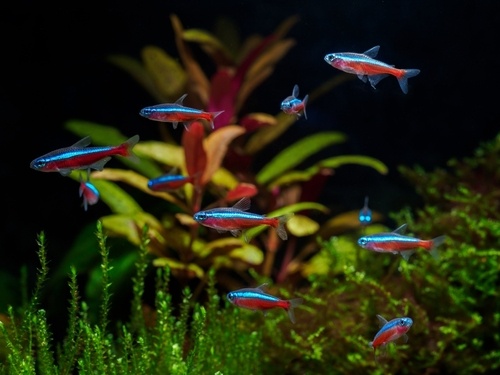
As Neon Tetras are small, it can be easy to assume their needs are simple. However, in truth, they need more than the bare minimum recommended tank size and if they have plenty of space they will be less stressed and you are less likely to see aggression and disease.
For a school of 5-6 Neon Tetras, a tank of minimum 10 gallons or 38 liters is recommended but your fish will fare even better with a 20-gallon/76-liter or 30-gallon/ 114-liter aquarium. This gives them more space to swim and explore, minimizes the chance of fights, and helps prevent pollutant build-up from fish waste.
5. Prevent Unnecessary Causes Of Death
Last but not least, as outlined in our ‘tankmates’ section, it’s best to prevent any unnecessary fish deaths such as those caused by predation or tank accidents.
Generally, understanding your species and taking the time to set up your fish tank properly is the best way to ensure everything goes off without a hitch.
Myths and Misconceptions About Schooling Fish
Myth: Small fish don’t need a properly set up tank.
Reality: Small fish need plants and a proper tank environment. This also means correct filtration, lighting, and appropriate tankmates!
Myth: Small Tetras can survive in an unfiltered tank.
Reality: A filtered tank is ALWAYS better for ANY fish. In an unfiltered tank, even one with plenty of plants, dangerous levels of ammonia, nitrates, and nitrites can build up. In addition, this can decrease the level of oxygen in the water and it can become stagnant. Always use a filter – your fish will thank you for it!
Myth: All small schooling fish are the same.
Reality: Each species is unique and may have different requirements in terms of water pH, tankmates, temperature, lighting, and so on. For example, the Cardinal Tetra, which looks very similar to the Neon Tetra, actually has relatively different needs, as it is generally wild-caught and is much less hardy.
Bottom Line
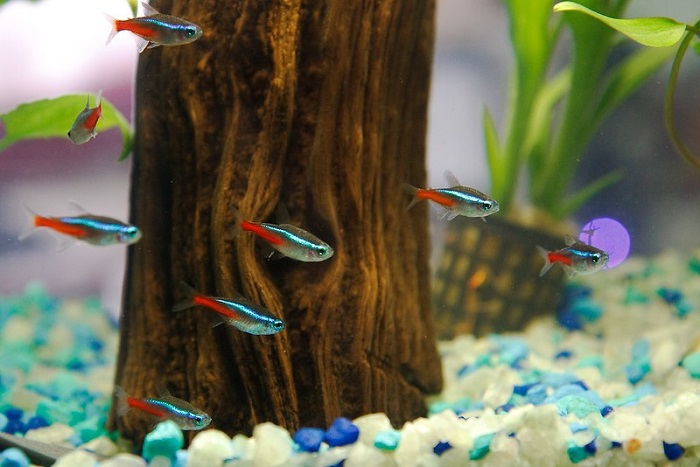
To sum up, basic Neon Tetra care is similar to any other small schooling fish, however, this species and other similar ones definitely have a few misconceptions about them. It’s easy to think of small schooling fish as only having basic needs, however, this could not be further from the truth!
This guide should be a start as to how understanding Neon Tetra needs can help extend their lifespan – and give you a beautiful tank full of healthy and interactive fish.


